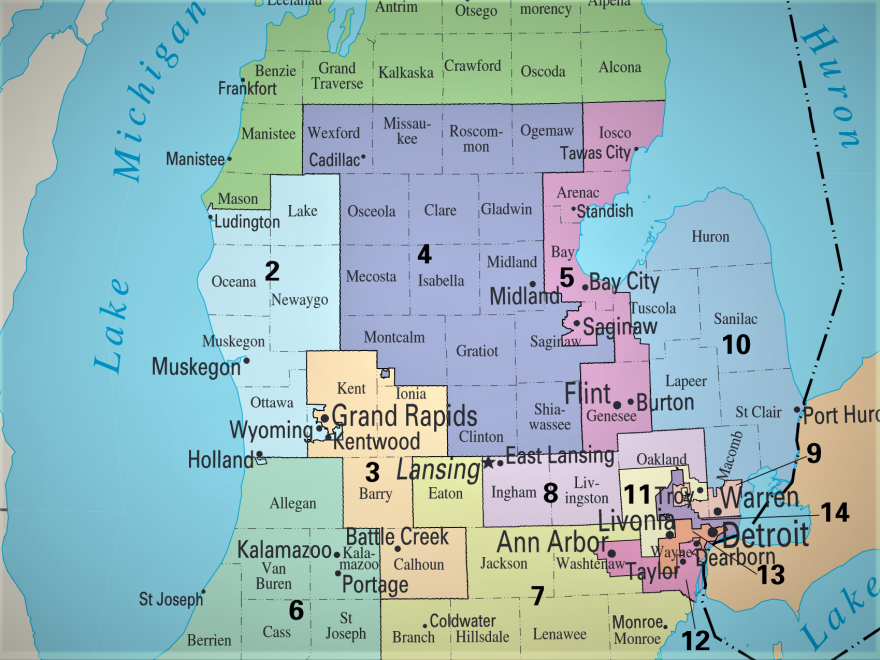In 2018, Michigan voters passed the Independent Redistricting Commission Initiative (Proposal 2). In doing so, they commenced a process in which everyday citizens — rather than people who hold political office — draw the state’s new legislative districts, which are based on data from the 2020 Census. Now that the Census has finished gathering data from the public, who exactly is doing the work of redefining Michigan’s congressional boundaries? That would be a group of 13 randomly selected Michiganders who make up the state’s Independent Citizens Redistricting Commission. And maybe you, too.
[Get Stateside on your phone: subscribe on Apple Podcasts or Google Podcasts today.]
To find out more about what the commission’s responsibilities are, as well as how public input affects the redistricting process, Stateside spoke with Sue Hammersmith, executive director of the commission, and Nancy Wang, executive director of Voters Not Politicians, the nonprofit organization that successfully campaigned for the citizen-led redistricting model in 2018. Here’s what you should know about how the commission works:
Why does the commission exist?
If you take a look at the Michigan congressional district map, you might notice that some pretty unusual shapes make up the mitten. Some of those zig-zag lines are drawn to benefit a particular political party — and that’s because, until Proposal 2 passed in 2018, lawmakers from the majority party in Lansing decided where to divide the districts.
Voters Not Politicians helped to change that when they pushed to get Proposal 2 on the ballot. Once Michigan voters approved the change, the process of creating the Independent Citizens Redistricting Commission began. And now, despite the COVID-19 pandemic, they’re getting to work.
“We’ve been marveling at the kind of realization of our vision — really, the Michigan public’s vision — of this really transparent, citizen-led process that is fair and impartial,” said Wang. “It puts voters first and at the center of redistricting, which of course is completely opposite of what we had before, with gerrymandering.”
What is the commission’s job?
Wang says the commission’s task is to draw federal and state legislative districts that reflect the make-up of the state as well as community members’ perspectives.
“The commission has to take in account and preserve these communities where they exist, in order that they can vote when they have a shared interest, be it economic or cultural, and so that they can elect the representative of their choice,” Wang said.
2020 Census data will play a key role in the commission’s decision-making process, but much of that information won’t be available until July — and the final map is due by November 21, 2021. That means late summer will be a busy time for the commission, says Hammersmith, who oversees but doesn't vote on the commission.
“We'll just have to have everything in place so we're ready to go,” she said. “It's going to be very tight on the timelines, but these are mandated in the Constitution, and the commission will meet the timelines.”
What is the commission doing now?
Hammersmith says the commission has a lot of work to do, so they’re moving quickly. The group, which is composed of Republicans, Democrats, and individuals who aren’t affiliated with either party, has been meeting virtually amid the pandemic.
“I’m really amazed at how respectful they are of each other and how committed they are to the mission of the redistricting so that it will be fair and non-partial,” Hammersmith said.
But they aren’t making decisions about congressional boundaries without any input. In addition to examining census data, the commission is seeking input from other Michigan citizens. So, a number of organizations, including Voters Not Politicians, are part of an ongoing effort to bring public attention to the commission’s work, Wang says.
Why does public participation matter?
The 13 commissioners have plenty of responsibilities. The decisions they make could impact the number of seats Democrats or Republicans have in Congress, and they could also shift the politics of the state Legislature. That means there’s a lot the commission needs to learn from Michiganders about the communities in which they live, says Wang.
“What makes you a community? … What interests do you want to be represented in Lansing or in Washington, D.C.?” said Wang. “They need to know what interests you have and then also where the boundaries are of your community. So, does it go past this highway? Does it go this far north? What are your landmarks that identify where your community should lie, and not be broken up?”
Hammersmith says all the commission’s work is done through open meetings, and anybody can see it and submit comments. Right now, because the meetings are virtual, you can sign up for updates through Secretary of State Jocelyn Benson’s website. And you can find out more and watch recordings of meetings on YouTube and Facebook.
“We really welcome people to get engaged with us in any way, whether it’s attending meetings and only watching, or whether they want to give public comment, we welcome that citizen participation," said Hammersmith. "That’s why ‘citizen’ is in the name.”
This post was written by Stateside production assistant Nell Ovitt.






